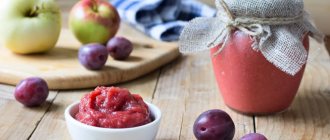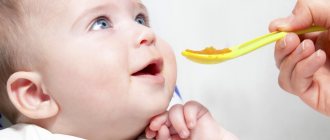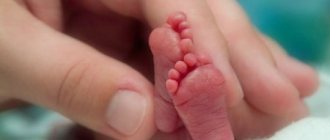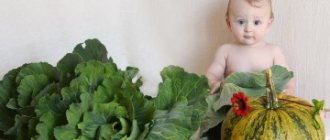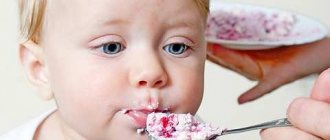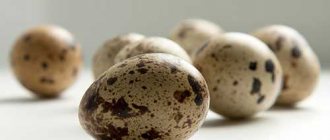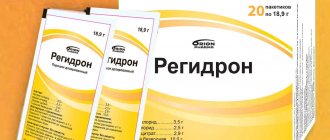Once upon a time there was a belief that if you start giving a child fish early, he will not talk. And if the child was lagging behind in speech development, then this particular product was blamed. Modern young mothers know that fish is very healthy, and giving it to your child is not only possible, but also necessary.
Fish contains a lot of phosphorus, iodine, iron, zinc, vitamins of various groups and essential fatty acids. They are necessary for the full development of the child’s body and normal mental activity. The only question that arises is when to introduce it, how much to give and what kind of fish is suitable for the first complementary feeding?
Content
- How much fish can you give to children?
- What fish can a 1 year old child eat?
- Which fish is suitable for children over 3 years old?
- About the health benefits of fish
- How to cook fish for kids
Starting from 8-9 months, fish can be included in a child’s diet, as it is a source of easily digestible protein, minerals and amino acids. However, it is recommended not to give it more than twice a week to avoid an allergic reaction.
Let's talk about what kind of fish a one-year-old child can eat, in what form, and why this product is so useful for children.
Is all fish good for all children?
Fish is a product that can cause allergic reactions; mothers who intend to introduce it to their child as complementary foods should take this into account.
You should not give your child seafood - mussels, shrimp, etc., as they cause severe allergies.
There is an opinion that sea fish are cleaner than river or lake fish, because they swim in cleaner waters that do not contain heavy metals and other harmful substances. True, this issue is controversial. Moreover, sea fish not purchased at a seaport may be far from fresh, defrosted several times or frozen in an unknown way. Also, when buying fish for a child, you should not pay attention to exotic varieties of fish such as sea pike, madder, etc., which may contain toxic substances.
Butyric fish contains fatty acids that are poorly digested by the human body, which can cause intestinal upset in a child.
Fish is a perishable product. In addition, it must be subjected to appropriate heat treatment, since it is contaminated with parasites and, if improperly prepared, can cause the appearance of helminths.
How much fish per day can be given to children from 8 months: table
Fish is a fairly allergenic product, and it is not the fish itself that can cause a negative reaction, but the substances it contains. Therefore, at the first signs of intolerance, it should be excluded from the diet and postponed until an older age.
To determine. in what quantity to give fish to your children, refer to the table:
| From what age | How many |
| From 8-12 months | From 5 to 30 g |
| From 1 year to 3 years | 30-50 gr |
| From 4 to 7 years | 50-70 gr |
| From 7 to 14 years | 70-100 gr |
| From 14 years old | 100-20 gr |
Which is better?
All mothers know: children are incredibly capricious when it comes to food, especially food that is given to them for the first time. In order not to discourage the desire to eat it, it is necessary to offer food in the form in which the child is accustomed to seeing it. In other words, it is best to give your baby fish puree for the first time. No spices, salt or any additives. According to all the rules of complementary feeding, starting from 0.5 tsp. and gradually increasing the portion to 50 - 70 g. 2 times per week.
To prepare the puree, take boiled fillet. How long should you cook it? For 100 gr. hake 20 minutes in boiling water is enough. Subsequently, small pieces of fish are boiled for about 15 minutes, and large pieces for up to half an hour or more. After the allotted time, the finished product must be removed, cooled and ground in a blender. To improve the taste of the dish, the puree can be seasoned with a drop of vegetable oil.
You can also offer your little one steamed fish. Meanwhile, it is best suited as a tasty addition to vegetable soup. In any case, it is important to remove all the bones from the hake, giving it freshly cooked each time. Storing the finished product in the refrigerator can lead to the development of pathogenic microorganisms in it, which will harm the baby’s health.
If your picky little one doesn’t like the new dish, it makes sense to offer it a few days later as part of vegetable puree or even postpone getting to know it until later. However, if everything went well, after a few weeks you can offer your baby fish cutlets or meatballs, steamed or boiled in broth.
Frying or smoking a product for a child is allowed only after he reaches the age of three, otherwise problems with the gastrointestinal tract may occur.
What kind of fish can children under one year old eat?
At this age, the body is quite whimsical, so according to tradition, all the best and safest is for kids. Some tips for choosing fish for small children:
Marine or freshwater
Nutritionists agree that sea and ocean fish are the most suitable for introducing a baby to this product. Firstly, because it is the most environmentally friendly. Secondly, it contains more nutrients. And thirdly, there are fewer bones and they are larger, so you are more likely to fillet them.
Red or white
Red fish is very popular among adults, but for children aged 10 months it is better to eat white fish. It is less allergenic.
Do you know that the red color of some types of fish is due to their diet - they eat reddish crustaceans. This red pigment accumulates and gives their meat its color.
By fat content
Fish seems to us to be one of the most dietary foods. This is true, but do not forget that some varieties can contain more than 30% fat. In the first months of life, the child should try only low-fat varieties of fish (no more than 4% fat), as they are digested faster and easier. These can be: hake, flounder, cod.
Leave medium-fat fish (for example, catfish or sea bass) until they are one and a half years old.
Frozen or fresh
Of course, freshly caught fish is the best option for first feeding. The main thing is to choose it correctly. A product with a smell (even a slight one) – we immediately say “no” to the seller. To properly appreciate the aroma of the fish, try to bend back its gills - there should be no smell in this place other than the sea.
Fresh fish should also have:
- Beautiful colour
- Clear eyes
- Elastic and shiny scales
Don't be too afraid of fresh frozen fish. If stored correctly, the product will not be inferior in beneficial properties to fresh. If you trust the seller, you can safely take the frozen one. Defrost it slowly, first in the refrigerator and then at room temperature - this will preserve its texture.
What to pay attention to: Frozen fish should not have a thick ice crust. This appearance suggests that it has already been defrosted. But such a product should not be consumed by adults, much less small children.
How and when to introduce fish into complementary foods for children?
Fish contains a lot of useful and nutritious substances. These are important microelements such as zinc, copper, magnesium, phosphorus, iodine; These include polyunsaturated omega-3 fatty acids and complete protein, which are very well absorbed by the delicate children's digestive tract, necessary for the proper development of the baby. Moreover, proteins from fish are absorbed better than from meat: the former by 93–98%, and the latter by only 87–89%. This means that fish puree is a more dietary product than meat puree.
But fish also have negative qualities. First of all, we must remember that this is a very allergenic product. That is why children prone to diathesis should not be offered fish at all in the first year of life. And all other children can be given fish only from 8 months and no more than twice a week.
Culinary secrets: how to cook fish for a child
If you prepare fish for your child yourself, it is advisable to use unfrozen fish and in the form of fillets, that is, without any bones.
Until your baby is one year old, he will only eat fish in the form of fish puree, so you won’t have to worry too much about preparing it. Fish for complementary feeding just needs to be boiled, and it cooks very quickly. Just keep in mind: in order for fish to retain all its nutritional and taste properties for a child, there should be as little water in the pan as possible. To prevent the fillet from breaking into fragments during cooking, place it in a shallow bowl of boiling salted water so that it covers the fish by 4–5 cm. To improve the taste, add bay leaf, parsley, and onion to the water. Before boiling, cook the fish over high heat and finish cooking over low heat.
Make sure it is well cooked. To determine doneness, pierce a piece of fillet with a fork. Does it produce cloudy juice? Place the fillet back into the pan to finish cooking. Is the juice clear and colorless? This means the fish is ready for the child!
Mash it with a fork on a plate, carefully checking to see if there are any small bones left in it. You should get a smooth, homogeneous fish puree without any pieces. If you can't achieve a puree-like consistency with a fork, use a blender.
And also keep in mind that the resulting broth should never be given to a child due to the abundance of extractive substances in it.
Fish for a child. Feeding according to science
The first portion of fish puree should be literally a quarter of a teaspoon. After this, wait 2-3 days, carefully observing the reaction of the child’s body. If the baby has not “bloomed” and his stool is fine, give him half a teaspoon of fish puree, and after the same time - a whole spoon. And so, offering a fish dish to an eight-month-old toddler every 3-4 days and gradually increasing the dose, increase its amount within a month from 5 to 30 g, and over the next month - from 30 to 60 g. A baby under one year old does not need more.
What should you do if your capricious categorically refuses to eat fish puree? Try a trick: mix it with your baby’s already familiar and favorite food, such as mashed potatoes. Gradually reduce the share of potatoes and increase the share of fish, and gradually the child will get used to the new taste.
Fish is very tasty for a child in combination with onions and carrots. Onions are introduced into the diet of babies from 10 months. Chop it very finely and simmer together with grated carrots, then mash with a fork until a homogeneous consistency and mix with fish puree.
Just do not forget that the fish dish needs to be diluted in time with the milk dish. You should not give fish puree and porridge with milk (or breast milk, or an adapted formula) at the same feeding. The fact is that one does not go well with the other and usually ends in a “revolution” in the children’s digestive tract.
The best time of day to introduce a child to fish is lunch. True, many mothers believe that it should be introduced at breakfast, so that there is more time to monitor the baby’s reaction to the new product. But believe me, if there is a negative reaction, it will not escape your attention at any time of the day. But in the morning its likelihood is higher, because babies usually have milk porridge for breakfast, and some are also given breastfeeding. What kind of fish is this!
What if a child is allergic to fish?
If your little one reacted to fish puree with a rash, this does not mean that in every such case you should forget about fish supplements for a long time. First, remember what kind of fish the child was given - the fact is that children react more sharply to sea fish than to freshwater fish. After waiting until all the signs of a child’s allergy to fish have disappeared, try offering the baby a different type of fish (for example, river fish instead of sea fish) or variety (there are cases when babies became covered in a rash after eating tuna, but pike perch was tolerated perfectly).
But if a child’s food allergy to fish worsens again, do not test the baby’s health and postpone introduction to fish dishes until the second year of life. By this age, the enzyme systems of the children's stomach and intestines will have matured sufficiently to better assimilate this product and prevent large fragments of fish protein from entering the bloodstream, which act as provoking allergens.
Choosing the right fish for complementary feeding
Great care must be taken when purchasing fish for complementary feeding.
- No expensive varieties - sturgeon, beluga, stellate sturgeon are prohibited, as they are extremely allergenic and too fatty.
- For the same reason, and also because of the red-pink color, which is a factor of additional sensitization, it is not recommended to give infants puree from salmon, trout, and salmon.
- Not only the substances that give fish flesh its characteristic bright color, but also fish oil can cause a severe allergic reaction in a small child. That is why pediatricians abandoned its use at an early age, replacing it with safer preparations containing vitamin D.
- But hake, pike perch, perch (just keep in mind that it has a lot of bones!), cod, and pike are perfect for feeding your little ones fish.
- First, give one type of fish, for example, cod, and then begin to accustom your baby to another, then to a third, etc.
Doctor's advice
It is unlikely that anyone will treat a baby to lobsters or even shrimp, which are popular among us. But for some reason, many mothers without any hesitation add fish caviar to their babies, for example, in mashed potatoes, because they consider this type of food extremely healthy. In fact, you should wait a little while introducing caviar into your baby’s diet. It is indeed very nutritious and rich in vitamins, but all the benefits of this valuable product are offset by its high allergenicity, especially for children under one year old.
What fish can a child over 3 years old eat?
Of course, these children can eat all the same varieties as kids, and also add new ones.
For example, three-year-old children can be given medium-fat and oily fish. Fatty fish (from 8% fat) include mackerel, herring, salmon, pink salmon and many others.
From the age of 3, a child can eat both red and white fish, regardless of the habitat.
The benefits of fish for children
If the baby does not suffer from food allergies, then fish will be very useful for him. It is rich in protein and essential amino acids. Protein, as you know, is an important building material needed by the baby’s body. If there is insufficient protein intake, the child will not be able to grow and develop normally.
The protein content in fish ranges from 8 to 23% depending on its variety. Due to the low elastin content (5 times less than meat) and the absence of collagen, fish is easily boiled. And accordingly, it is absorbed better than meat products. On average, absorption reaches 95%.
PUFAs in fish (arachidonic acid, linoleic acid, linolenic acid) improve brain function and contribute to the normal functioning of the cardiovascular and endocrine systems. Fish is an excellent source of vitamins A, E, C, D, K. It contains B vitamins and pantothenic acid, minerals that ensure good metabolism. Fish contains macro- and microelements such as iodine, calcium, iron, magnesium, manganese, zinc, fluorine, phosphorus, potassium, sodium.
If we compare sea and river fish in terms of the content of nutrients, then sea fish wins in this regard. It is especially rich in iodine. But the majority of residents of our country live in conditions of iodine deficiency.
On the one hand, sea and ocean fish are healthier than those found in rivers and lakes. However, there is another problem. Most residents of our country cannot buy fresh sea fish, when their benefits are maximum. We usually buy it frozen. While the fish goes through all stages of transportation, it is unknown in what conditions it was stored and how many times it was defrosted. Therefore, there are not many useful substances left in such fish. Fish that is not stored in accordance with the terms and conditions can simply be hazardous to health.
But river and lake fish are much more accessible fresh. Accordingly, you can get more benefits from it. However, it contains a lot of bones and should be given to babies with even greater caution. River fish can also be infected with parasites. In order for the fish to bring maximum benefit, it must be selected correctly and well thermally treated.
Why fish must be present in children's diets
From early childhood, accustom your child to the taste of fish. This product will help not only diversify the children's menu, but also take care of the baby's health.
Benefits of fish for children's health:
- As we have already said, fish is a protein that is easily digestible and is ideally suited for a fragile digestive system and reduces the load on the pancreas. But there is never too much protein for a growing body.
- The product is rich in essential amino acids, which also benefits the development of the child.
- Fish contains a large amount of vitamin D. In combination with calcium, this substance builds bone tissue and the skeleton. A deficiency of this substance at a young age can cause rickets and other bone diseases.
- Vitamin A, which increases the body's resistance to viral diseases.
- Fish will help replenish iodine deficiency for healthy thyroid function and proper brain function.
From what months can you give your baby fish?
Despite its usefulness, fish is different in that it contains many allergens that very young children cannot cope with. And some parents don’t know when to introduce fish into complementary foods.
So, fish is considered to be a late complementary feeding. Most pediatricians agree that fish should appear on a baby’s menu no earlier than eight months. If a child shows signs of an allergy, this product will have to be put off for a long time - at least two or three years, until the body gets stronger. Since fish is a late complementary food, before it appears in the diet, the baby must get used to vegetable complementary foods, cereals, meat and dairy products. If you delay in introducing these foods, you will have to wait with fish - first prepare the child’s body for the simplest food, and only then move on to the heavy one.
In what form should children be given fish?
Children under one year old can only eat fish fillets, crushed to a homogeneous mass. You can boil the fish and chop it yourself with a fork, or use fish puree, which is now available in a large variety on the shelves.
Fish puree is produced according to the high requirements of baby nutrition and undergoes thorough testing. It contains no artificial additives, only spices, salt, fish, cream and vegetables. Therefore, you can be sure of its quality and safely give it to your child from 8 months.
At what age can children eat salted fish? Not earlier than three years, and in small quantities. It is best to cook fish stewed, steamed or cooked in fish broths. But fried fish can only be eaten after 5 years. Even later, you should introduce your child to smoked fish.
What should you avoid when introducing fish into your baby’s diet?
Firstly, until the child is one year old, he should never be given caviar, because it is very difficult for the body and most often causes allergic reactions.
Secondly, the baby should not eat dried, salted, smoked fish and canned fish, which are not part of commercially produced baby food.
We recommend that you also read: “What a child under one year old should not eat.”
Thirdly, it is better not to experiment with other seafood (shrimp, mussels, crabs, rare varieties of fish, fish with red meat) until the child is at least one and a half years old.
What fish products should not be offered to children?
- Even adults should eat all kinds of canned sprat, sprat or herring in limited quantities. For children, especially, we choose something more dietary.
- Semi-finished products from fish raw materials and “crab” sticks from minced fish - we exclude surrogates from the children's menu.
- Nutritionists advise giving smoked fish only to older children.
- Exotic fish, as well as seafood - due to the high sensitivity of the children's digestive system.
- Caviar, as it is too fatty for small children.
- Fish that doesn't make you feel confident about its freshness.
Fish for first feeding
Fish is a very healthy product that a child’s body needs. Fish for the first feeding should be carefully selected and properly prepared. This way it will enrich the baby’s body with the substances necessary for growth and development. There is no need to rush into introducing this product. There are certain age restrictions for introducing a child to fish dishes.
What are the benefits of fish?
This product combines pleasant taste and nutritional value, with an abundance of vitamins and minerals.
It is considered a dietary food, improves metabolism and does not cause excess weight gain.
Many nutritionists note that the diet should contain more fish than meat dishes. Meat protein is absorbed by the body by approximately 88%, and fish protein - from 93 to 99%.
It is easier for a child’s body to digest fish, but this product is introduced into complementary foods after meat. This is explained by its allergenicity.
Fish dishes are necessary for the baby's developing body. Their benefits are manifested in all body systems. They:
• reduces cholesterol levels;
• normalizes blood clotting;
• helps new cells form;
• stabilizes the functioning of the thyroid gland;
• improves memory and brain function;
This product also improves skin condition; strengthens hair, nails, teeth; serves to prevent heart and vascular diseases.
When is fish introduced into a child’s diet?
The World Health Organization recommends introducing it to your baby no earlier than 9-10 months. And only if the child is not allergic to this product.
It is also an unspoken rule that this dish is introduced no earlier than 2 months after the child is introduced to the first complementary foods.
Dr. Komarovsky believes that fish should appear in complementary foods no earlier than 10 months. At this time, the baby can eat no more than 5-20 grams per day.
The first fish enriches the children's menu when he has tried and regularly consumes vegetables, fruits, cottage cheese, kefir, egg yolk, and meat.
It is recommended to mix the product with vegetable puree. For this you can use potatoes, cauliflower, zucchini, carrots.
This way, the new dish will definitely be well absorbed by the child’s body.
It is not recommended to give your baby fish and meat complementary foods on the same day.
How much fish can you give your child?
For the first time, you can give your child no more than a teaspoon. Then gradually increase the portion to 30-50 grams. It is important to carefully monitor your baby's reaction.
If the slightest signs of an allergy appear, you cannot continue feeding him this product. You can try again after 2-3 weeks.
Useful tips for mothers: FIRST FEEDINGS
In this case, it is better to try cooking a different variety. Perhaps a certain variety is not suitable for the baby’s body, but he will eat another without the slightest sign of allergy.
The best time to try a new dish is breakfast. This makes it easier to assess how the child reacted to it.
After introducing the product, you can cook it for your child 2 times a week instead of meat dishes. During this period, it is best to cook it for lunch.
A child under one year old can be given no more than 50 grams per day. If such puree is offered along with vegetables, then the serving should not exceed 150 grams.
If the baby refuses such food, you should not force feed him.
You can offer this product again after 2 weeks.
If complementary feeding is successfully introduced, after a year you can diversify your dishes by preparing casseroles, cutlets, and soups from fish.
Which fish is suitable for first feeding?
The first should be marine species. Then the child can be introduced to river varieties.
The product must be non-greasy. Which one can be offered first: cod, pollock, hake, sea bass. There are a lot of bones in crucian carp, bream and perch. They need to be cleaned especially carefully.
When purchasing ready-made puree, it is important to follow age recommendations.
You need to start with fish products labeled “from 8 months.” They should not contain spices or starch.
How to prepare fish for first feeding
It is important to choose a quality product. Semi-finished products are not suitable for complementary feeding. The fish must be fresh or fresh frozen.
You should evaluate her appearance. The eyes should be light without a film, the gills should be pink, the scales should be shiny, and the smell should be fresh.
The product is defrosted, cleaned, and cut into pieces. Then put them in boiling water and cook for half an hour. After cooking, all bones are removed from the product and pureed using a blender.
When cooking river varieties, it is recommended to drain the water 5 minutes after boiling and add new water.
You should not mix several types of fish. So, if an allergy occurs, it will be difficult to assess which particular variety caused a negative reaction in the child’s body.
Fish complementary foods are prepared every time before treating the child. It is not recommended to keep pre-prepared food in the refrigerator.
For better digestibility, you can add a little vegetable oil to the puree.
You should not offer your baby regular canned food that adults eat. It is better to postpone such a product until the child is 4 years old.
